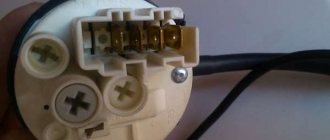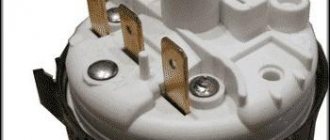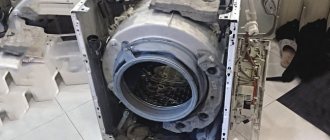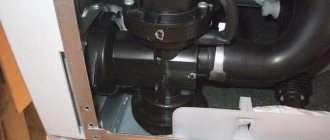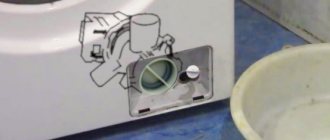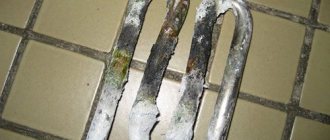Design and principle of operation of the device
Before checking the part, it is recommended that you familiarize yourself with its design features and operating principle. A pressure switch is a part that is responsible for controlling the volume of water in the washing system. Different operating modes of washing equipment require different amounts of water. Therefore, when switching, a level switch is used to check the amount of liquid in the tank.
The part is made of high-quality plastic and has a round shape. It connects to electrical wiring and a hose to determine pressure. Inside there is a switch with a thin membrane. When the system is filled with water, pressurized air will flow through the hose, causing the switch to close. After this, the system will stop taking in new fluid.
What is this detail?
Modern automatic machines have many components and components. Each part performs a specific function. The pressure switch monitors the water level in the tank. The sensor measures how much liquid is in the “centrifuge”, focusing on the pressure in the tube.
The relay is made in the form of a disk. Inside the pressure switch there is an air chamber with a diaphragm, a magnetic core and a tube. Sensors can be of simple or complex types, differing in the sensitivity of the membrane and the stroke of the rod.
The pressure switch from one machine does not always fit another washing machine. Therefore, if the factory sensor breaks down and requires replacement, be sure to look for and buy an analogue, focusing on the model and serial number of the machine. The “shell” of the pressure switch is made of high quality plastic. Externally, the relay resembles a washer. The sensor is assembled from the following components:
- plastic “shell” (body);
- coil;
- membrane. She is able to change shape under pressure and press a switch;
- magnetic core (plays the role of a switch);
- wires.
Depending on the model of the automatic machine, the pressure switch needs to be looked for in different places. The water level sensor is installed:
- under the top panel of the case (on most front-facing cameras);
- from below, under the tank (in “verticals”);
- at the back of the body, just below the tank. This arrangement is typical for SMAs with plastic drums.
Now it’s clear how the pressure switch works and in which part of the washing machine to look for it. We will also analyze the principle of operation of the level sensor. Let's tell you what its role is in an automatic machine.
Symptoms of a problem
Sometimes it is quite difficult to determine the malfunction of a product, especially for people who do not understand technology. It is recommended that you familiarize yourself with the common signs that indicate a faulty pressure switch.
Stops drawing water into the tank
People who have their own washing machine often experience that liquid stops filling into the tank. There are several reasons for this problem:
- Problems with the valve responsible for supplying water. Liquid enters the system under tap pressure. The supply is opened using a special built-in valve, which begins to operate after a signal from the control module. If it is faulty, the liquid will not begin to flow.
- Control module failure. Due to a malfunction of this part, the valve does not receive a signal, and it does not begin to draw water.
- Blocker failure. He is responsible for blocking the hatch door. If the lock is faulty, the machine will not start working.
See also
Instructions on how to repair bag handles with your own hands
However, the most common cause is considered to be a faulty pressure switch. If this product does not work, the machine will not be able to evaluate and will not begin to fill the tank.
Repeated cycles of water supply and drainage
Modern washing machines are equipped with an automatic liquid collection system. Not only valves, but also level switches are responsible for the flow of water. All these parts function using special commands coming from the control unit.
A failure in one of the listed parts results in the system not being filled with the required amount of fluid.
The control unit perceives this as a failure to comply with the command, and therefore it re-sends the signal to supply water. This results in the supply and drain cycles being repeated many times. Due to repetition of cycles, the washing time can increase significantly.
Reduced rinse and wash quality
Sometimes, after using a washing machine for a long time, the quality of rinsing and washing clothes gradually deteriorates. Many people attribute this to the use of inappropriate powders. However, there are other reasons why things begin to wash worse.
A common reason for poor washing quality is a faulty level switch. Due to the breakdown of this part, the washer cannot determine how much water is in the tank, and because of this, it often does not fill completely. This leads to the fact that the collected liquid is not enough to properly wash and rinse the washed items.
Water remains after finishing washing
There are times when, after completing work, some water remains inside the drum. This can happen because the pressure switch has failed and stopped functioning normally. If it does not work correctly, the control unit of the device will not receive a signal about the need to clean the tank. This will lead to the pumps not starting to work to pump out excess water.
However, there are other reasons for this problem:
- Pump filter clogged. Obstruction of liquid from the tank sometimes occurs due to a clogged filter. It will have to be cleaned for the drain to start working.
- There is a blockage inside the pipe. During the draining process, the waste liquid passes through the pipe. Experts advise cleaning it once a month to prevent it from becoming clogged.
Checking the pressure switch
If you have the slightest doubt about the correct operation of the pressure switch, you must immediately replace it with a new one. But before that, you need to gain confidence that the problem is with the sensor. Checking the pressure switch of a washing machine is quite simple:
- The top panel must be removed. You can remove it by unscrewing the special bolts and sliding it in the opposite direction from you. On most models, the sensor is located at the top of the side wall.
- Experts recommend simply unscrewing the pressure switch. It is usually secured with several screws, which are quite easy to unscrew.
- After this, disconnect the tube and contacts from the sensor. The hose is secured with special clamps; they will either have to be carefully disassembled or cut off and then replaced with new ones.
Carefully examine the dismantled pressure switch: there should be no damage or formations on the housing. Check the tube and the condition of the insulating material of the wiring no less carefully. If necessary, clear blockages and repair minor damage. Clean the sensor contacts.
Now let's check the device itself. Typically, a ten-centimeter hose is used for this, identical in diameter to the one already removed earlier. Having connected the tube to the inlet fitting of the pressure switch, blow strongly into it.
At this moment, clicks should be heard from the sensor. Their number depends on the blowing force.
This small device is necessary for the entire system. When it fails, it deprives you of the ability to wash, and can lead to various breakdowns. Replacing the pressure switch in an automatic washing machine is a troublesome, but not complicated process.
Pay attention to the behavior of your machine, and you will be able to notice a malfunction in time
After some time from the moment of operation of the washing machine, any of its elements may lose their functionality. For example, a violation of water intake, expressed in underfilling or overfilling of liquid, will tell you that there are problems with the sensor that controls its intake. It is not always necessary to replace it; sometimes it is enough to adjust the pressure switch of the washing machine so that it works normally. By performing these steps yourself, you will not spend extra money on a new element and will extend the life of the existing sensor.
Consequences of ignoring the problem
Failure of the pressure switch leads to serious consequences, which should be familiarized with in advance. If you do not replace the broken part in time, the following problems will appear:
- Water does not fill up. If the level switch is broken, the liquid stops collecting. In this case, the heating element may turn on, which will lead to further damage to the heating element. Therefore, before starting washing, be sure to check that the tank is not empty.
- Deterioration in wringing out washed items. Sometimes, due to a component failure, the fluid stops draining normally. Because of this, things turn out much worse.
- Tank overflow. Sometimes, due to a broken part, too much water is pumped into the tank, causing it to overflow.
See also
What to do if a computer chair creaks and how to fix the problem
Preliminary actions
As soon as you discover a malfunction, you should understand whether the reason actually lies in the part that controls the water level. It is necessary to carefully inspect the water intake system, check the sleeve and fitting of the water intake sensor, and the transition chamber section. When inspecting these parts, you should not find any tears or abrasions, as well as deposits from washing powder.
If detergent is detected on the parts, all components must be washed, after which a second attempt is made to start the washing machine. It is quite possible that you have restored the ability of the pressure switch to work.
Secondly, the correctness and strength of the electrical wiring connection to the part is checked. There is a possibility that one of the wires is worn out or bent. Having discovered such a defect, we eliminate it and perform a test run again.
Be sure to check the contact group of the pressure switch. If there is a deposit of dirt, clean it and again check the water intake sensor for serviceability.
Diagnostics is performed using a tube whose diameter matches the size of the part’s hose. We put one end of the tube on the instrument fitting, and blow into the second. If the part that controls the water intake is in good condition, light clicking sounds will be heard.
When this method of checking does not help identify problems, the pressure switch will have to be disassembled.
How to check the sensor
To make sure the sensor is working, you need to check it. There are several useful recommendations that will help you check the serviceability of the part.
Where is
Before proceeding with dismantling, you should understand the location of the product. Many washing machine owners mistakenly believe that the part is located inside the drum, but this is not the case. Most manufacturers install a level switch on top of the drain body, which is mounted near the side wall. This arrangement is considered very convenient, as it simplifies the removal of the product from the structure.
However, on some models the sensor may be installed in other locations. For example, in modern models of Samsung or Ariston washing machines, the part is installed on the right near the front wall. For cars, the relay is located in the central part of the left side wall.
How to dismantle
It is quite easy to dismantle the pressure switch yourself. However, despite this, you need to familiarize yourself with how to do it correctly. The dismantling process is carried out in several successive stages:
- Removing the top cover. To get rid of it, you will have to unscrew two bolts that are located on the back wall. The top cover is then carefully slid back and removed.
- Detaching a part. The relay is connected to wires leading to the control unit and a hose. Before removing the product, you must carefully disconnect the wiring and hose.
- Removing the pressure switch. It is connected to the wall with mounting bolts that must be unscrewed.
Checking with a multimeter
There are different methods for checking the functionality of a device, but most often they use a multimeter for this.
Before you begin testing, you must carefully study the electrical circuit of the device and carry out preliminary setup of the tester.
It is set in advance to resistance mode, after which the probes are connected to the contacts of the removed part. After connecting the probes, the values on the tester display should change. If the numbers have not changed, then the relay is faulty and will have to be completely replaced with a new one.
See also
Diagram and step-by-step instructions on how to connect a backlit mirror in the bathroom
Procedure for replacing the pressure switch
Before changing the pressure switch of a dishwasher or washing machine, you need to check the equipment and make sure that it really does not work. You can check whether the pressure switch is working and which specific part has failed in several stages:
Completely disconnect the machine from communications, turning off the water supply, drainage and electricity; Place the washing machine or dishwasher on a moisture-absorbing cover (for liquid residues) so that you have access to the water tank; Next, remove the outer cover and, based on external signs, locate the water tank and water pressure sensor with a tube; Next, you need to carefully unfasten the tube and check it for blockages, then blow into it, listening to the sensor itself. If the device is working properly, after air is supplied inside, a characteristic click of the membrane should be heard (possibly with a short delay of 1-2 seconds)
If punctures are found on the hose or it is clogged, you can replace the hose without replacing the main element; The electrical circuit is checked using an Ohmmeter, which should show a gradual decrease in resistance on the contacts coming out of the pressure switch housing; If a click is not heard or the resistance remains unchanged, this means that the device is faulty and needs to be replaced.
The entire replacement process consists of carefully unscrewing the mounting bolts and dismantling the faulty device, in whose place a new one is installed. In this case, it is advisable to use a tool suitable for this - special Phillips screwdrivers and pliers, and also purchase the exact sensor model that was installed on your equipment.
Otherwise, it will not be possible to guarantee adequate operation of the entire system, which may lead to failure of its remaining elements.
Do-it-yourself manual adjustment
If the breakdown turns out to be minor, you don’t have to buy a new part, but simply manually adjust the old one. When setting up, adhere to the following recommendations:
- It is necessary to determine the optimal amount of water for the washing machine. For each model there is an optimal volume of liquid that is needed to complete the programs. Therefore, it is necessary to find out in advance how much water should be poured into the tank for washing and rinsing things.
- Configure. On the surface of the product there are adjustable screws that are adjusted depending on the required amount of liquid.
Where and at what price can I buy a water level sensor?
To avoid low-quality crafts, it is better to buy new water level sensors for Indesit washing machines at the service centers of the manufacturer.
When purchasing, you must indicate to the seller the name and modification of the washing machine or the pressure switch code (numbers, letters, signs printed on the body of the part).
The average cost of a pressure switch for an Indesit washing machine is 1,500 rubles.
How to replace it yourself
In case of more serious damage, you will have to replace the broken product. However, before replacing, you must purchase a new pressure switch. To do this, you will have to take the broken product with you to the store and buy exactly the same one.
Replacing a part is carried out in several successive steps:
- Removing the old relay. To remove the broken part, all wiring and hoses are disconnected. This must be done very carefully so as not to accidentally damage anything. Then the mounting bolts that secure the housing are unscrewed.
- Installing a new relay. The structure is bolted in place of the old one. Then a hose is attached to it using a clamp and the electrical wiring is connected.
Settings
For the level sensor to work correctly, it must be configured, but this is not the concern of the owner of the washing machine, but the manufacturer, since the setting is carried out and checked in production. However, there are situations when the owner of the equipment wants to change the pressure switch settings. This can be done by tightening the adjusting screws on the part.
Operating rules
To prevent the pressure switch from breaking, you must use washing equipment correctly. There are several operating rules that should be followed when using the machine:
- The machine cannot be used idle. Before starting the wash, the drum is filled at least halfway. If it is empty, the pressure switch will quickly break.
- Wash in warm water. Its temperature should not exceed forty-five degrees.
- Clean the drain regularly. To ensure that water drains well from the tank, you need to clean the drain hose once a month.
Repair
Having removed the pressure switch from the washing machine, first of all you need to see if the sensor itself is damaged, and also evaluate the integrity of the hose. It is also important to check if there is any blockage inside the tube. Replace the damaged tube with a new one, and if it is clogged, it must be cleaned. Next, the pressure switch contacts are inspected and, if necessary, cleaned.
